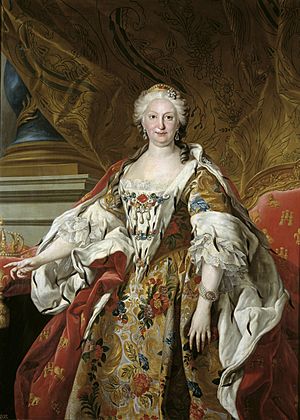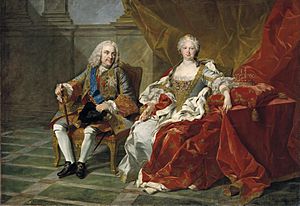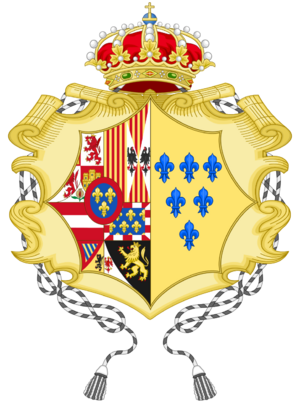Elisabeth Farnese facts for kids
Quick facts for kids Elisabeth Farnese |
|||||
|---|---|---|---|---|---|

Portrait by Louis-Michel van Loo, 1739
|
|||||
| Queen consort of Spain | |||||
| Tenure | 24 December 1714 – 14 January 1724 | ||||
| Tenure | 6 September 1724 – 9 July 1746 | ||||
| Queen regent of Spain | |||||
| Regency | 10 August 1759 – 9 December 1760 | ||||
| Monarch | Charles III | ||||
| Born | 25 October 1692 Palazzo della Pilotta, Duchy of Parma |
||||
| Died | 11 July 1766 (aged 73) Royal Palace of Aranjuez, Aranjuez, Spain |
||||
| Burial | 17 July 1766 Royal Palace of La Granja de San Ildefonso |
||||
| Spouse | |||||
| Issue see details... |
|||||
|
|||||
| House | Farnese | ||||
| Father | Odoardo Farnese, Hereditary Prince of Parma | ||||
| Mother | Dorothea Sophie of Neuburg | ||||
| Religion | Roman Catholicism | ||||
| Signature | |||||
Elisabeth Farnese (born October 25, 1692 – died July 11, 1766) was a powerful Queen of Spain. She became queen by marrying King Philip V. From 1714 to 1746, she was the de facto ruler of Spain. This means she was the real power behind the throne, even though her husband was king. She was especially known for her strong influence on Spain's foreign policy. Later, from 1759 to 1760, she also served as a regent, ruling the country for a short time.
Contents
Early Life in Parma
Elisabeth was born in the Palazzo della Pilotta in Parma, Italy. Her father was Odoardo Farnese, and her mother was Dorothea Sophie of Neuburg. After her father died, her mother married her uncle, Francesco Farnese, Duke of Parma.
Elisabeth grew up mostly hidden away in a palace apartment. She didn't get along well with her mother. However, she was very close to her uncle, who became her stepfather. She learned to speak and write Latin, French, and German. She also studied subjects like history and philosophy. But she wasn't very interested in these lessons. She preferred dancing, painting, and embroidery. She also survived a serious illness called smallpox.
Becoming an Heir
Elisabeth's father and uncles, who were supposed to inherit the Duchy of Parma, had no sons. This meant Elisabeth became the next in line to rule Parma. Because of this, many princes wanted to marry her. However, these marriage plans didn't work out. Later, her first son, Infante Carlos, inherited the Duchy of Parma. After he became King of Spain, the title went to her third son, Infante Felipe.
Her Marriage to King Philip V
On September 16, 1714, Elisabeth married Philip V of Spain in a ceremony where someone stood in for the king. This marriage was set up by Cardinal Alberoni, Parma's ambassador. He worked with the Princesse des Ursins, a very powerful lady at the Spanish court.
Elisabeth was a good choice for Philip V because Spain had a long-standing interest in Italian lands. Also, she was the heir to the Parma throne. The Parma ambassador convinced the powerful Princess des Ursins that Elisabeth was simple and easy to control. But at the same time, Cardinal Alberoni told Elisabeth that the king liked to be "governed" by others. He advised her to quickly take control if she wanted to be a happy queen.
Elisabeth traveled to Spain by land. On her way, she met with important people and received gifts. When she reached the Spanish border, she met Alberoni, who warned her about the Princess des Ursins. Elisabeth refused to let go of her Italian helpers, which was against the usual plan.
A Powerful First Meeting
On December 23, Elisabeth met the Princess des Ursins. The Princess wanted to introduce herself before Elisabeth met King Philip. But Elisabeth had heard that the Princess was trying to control her. Elisabeth asked to speak with the Princess alone. Soon after, people heard a loud argument. The Princess des Ursins was then arrested, fired, and sent out of Spain immediately.
Alberoni told the king that Elisabeth had done what was best for him. When Philip met Elisabeth on December 24, he quickly fell in love with her.
Queen of Spain

Elisabeth loved hunting and often wore men's riding clothes. She was known as an excellent shot and rider. She also spent a lot of money on herself and her friends. Her close friends included her nurse, Laura Pescatori, her Italian doctor, and Marquis Scotti.
At first, Queen Elisabeth was popular. People liked that she got rid of the Princess des Ursins, which seemed to free Spain from French influence. But soon, her complete control over the king made her unpopular. Spanish nobles also disliked her because she changed the formal court rules. People accused her of controlling the king and favoring foreigners.
Her Political Influence
Elisabeth quickly gained full control over King Philip. He seemed to want to be led by her. She was intelligent and charming, but also very ambitious. The French ambassador said she made the king believe that her wishes were his own.
King Philip often suffered from periods of sadness and couldn't handle government matters. During these times, Elisabeth took charge. These periods happened several times throughout their marriage.
Unlike other Spanish kings, Philip preferred to stay in the queen's rooms instead of his own. He even met his ministers there. This meant Elisabeth was present at all government meetings from the very beginning. At first, she would just sit and do embroidery. But soon, she started to take part more and more. Eventually, she would speak for her husband while he remained quiet. After 1729, they rarely left her rooms before the afternoon. They would then quickly do their official duties.
Philip didn't like formal court life. He preferred to live in smaller hunting palaces outside Madrid. This meant they were often not seen by the public, which led to criticism, especially for Elisabeth. After Cardinal Alberoni was dismissed in 1719, Elisabeth was effectively the sole ruler of Spain.
In 1724, Philip decided to give up his throne to his oldest son, Louis I. Philip then moved to the La Granja palace. But Louis died just seven months later. It was Elisabeth who, with help from ministers and others, convinced Philip to take the crown back.
Spain's Foreign Policy
Queen Elisabeth wasn't very interested in Spain's internal affairs. She focused more on foreign policy. Her main goal was to strengthen Spain's power in Italy. She also wanted to find thrones for her own sons, who weren't expected to become kings of Spain.
Elisabeth strongly supported Alberoni's plans to get back Spain's old Italian lands. This led to Spain taking over Sardinia and Sicily. She was so involved that when French forces attacked, she even led a part of the Spanish army. In 1719, she joined the king on his military campaign, dressed in blue and silver, encouraging her troops on horseback.
However, her plans faced challenges. The Triple Alliance stopped her goals. In 1720, the other countries demanded that Alberoni be sent away as a condition for peace. Spain also had to leave Sicily.
In Philip V's later years, when he was very old, Elisabeth guided all of Spain's policies. She worked to secure thrones in Italy for her sons. In 1731, her favorite plan came true. Her son Don Carlos (who later became Charles III of Spain) was recognized as the Duke of Parma. After the 1738 Treaty of Vienna, he became king of the Two Sicilies. Her second son, Philip, became Duke of Parma in 1748.
Queen Dowager
On July 9, 1746, Elisabeth's time as queen ended when Philip V died. Her stepson, Ferdinand, became the new king. Ferdinand, like his father, let his wife, Maria Barbara, handle government matters. People joked that "Barbara succeeded Elisabeth" rather than "Ferdinand succeeding Philip."
As the queen dowager (the king's widowed mother), Elisabeth didn't want to give up her power at first. She moved to a rented house in Madrid with her supporters. She demanded to know about government plans and openly criticized the new king and queen. In 1747, Queen Barbara decided to act. On July 23, 1747, Elisabeth was sent away to the La Granja palace. She lived there, away from the royal court and any political influence, for the rest of her stepson's reign. She held big parties where she welcomed foreign visitors and encouraged people who criticized the new king.
Elisabeth Farnese was involved in politics one last time after her stepson Ferdinand VI died in 1759. After his death, the Spanish throne went to her own son, Charles III, who was then the king of Naples. Elisabeth became the temporary regent of Spain from 1759 until her son Charles III arrived in 1760.
Between her husband's death in 1746 and her own death in 1766, she saw many changes. She saw her stepson, Ferdinand VI, become king. She also saw her beloved second son, Philip, become the Duke of Parma. In 1752, she built the Riofrio Palace as her home for her later years.
She spent much of her later life at the palaces of La Granja and Aranjuez. She died there in 1766 at the age of 73. She was buried next to her husband in the church of San Ildefonso.
Her Children
Elisabeth Farnese had six children with King Philip V:
- Charles III of Spain (born 1716 – died 1788): He married Maria Amalia of Saxony.
- Mariana Victoria (born 1718 – died 1781): She became Queen of Portugal by marrying King Joseph.
- Philip (born 1720 – died 1765): He became Duke of Parma and started the line of the House of Bourbon-Parma. He married Louise Élisabeth of France.
- Maria Theresa Rafaela (born 1726 – died 1746): She married Louis, Dauphin of France.
- Luis (born 1727 – died 1785): He was known as the Cardinal-Infante. He became Archbishop of Toledo and a cardinal. Later, he gave up his church titles and became the Count of Chinchón. He married María Teresa de Vallabriga and had children, but they did not have royal titles.
- Maria Antonietta Ferdinanda (born 1729 – died 1785): She married Victor Amadeus III of Sardinia.
See also
 In Spanish: Isabel Farnesio para niños
In Spanish: Isabel Farnesio para niños




